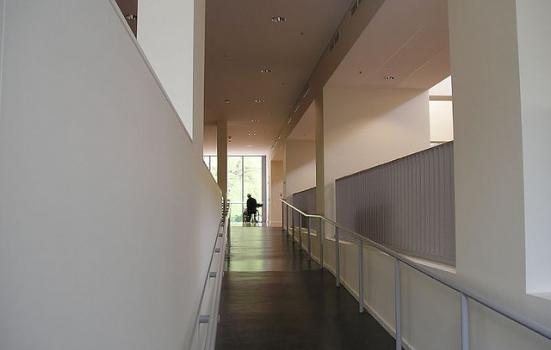Andrew Miller speaks out on discrimination in the arts, asking why “disabled people are nearly invisible with embarrassingly few leaders”.

Omer Ziv (CC BY-ND 2.0)
Discrimination is not what it used to be. We would all like to think the days are long behind us where an employer could merrily discriminate on the basis of gender, colour, sexuality or disability and that we now live in an enlightened time protected by relevant and enforceable legislation that would outlaw any such outrage. We all have lovingly crafted equal opportunities statements designed to prevent discrimination, don’t we? When our sector meets at networking events or conferences we can be justly proud of our diversifying workforce, certainly in terms of race, gender and sexuality. But look around the room and how many disabled people do you see? How many disabled leaders are there in the arts? The view that prevails in our sector is that we have sorted disability – our buildings are accessible so everything must be alright. As a mid-career arts professional with 25 years in the creative industries who happens to be disabled, I can tell you everything is certainly not alright. It is my contention that there is a lack of training opportunities for disabled people in the arts, and consequently disabled people are nearly invisible in our sector with embarrassingly few leaders. Despite complex legal frameworks, discrimination thrives, and if anything, it is more insidious than it ever was before. And I would like to suggest that it is a problem for all of us.
I have never been a campaigner, preferring to simply get on with my career in the mainstream arts, choosing my work environments with care and focusing on the job at hand. While the media has been trumpeting that the 2012 Paralympic Games ‘transformed attitudes’ to disability in the UK, I am left sceptical due to first-hand experience of discrimination and an increasing sense of isolation as a disabled person in a senior arts role.
Despite complex legal frameworks, discrimination thrives, and if anything, it is more insidious than it ever was before
But what should I be expecting? Let’s take a look at the stats.
From the most recently published government statistics, there are 11.6 million disabled people in the UK, currently 18% of our population (HM Government, Family Resources Survey 2011−12). Of these nearly 6 million are of working age and around 3 million actually work, amounting to 15% of the total UK workforce (Department of Work and Pensions, Office of Disability Issues, Labour Workforce Survey Quarter 2, 2012).
According to Arts Council England’s (ACE) National Portfolio Organisation survey 2012–13, 2% of the national portfolio’s total workforce is disabled: 1,261 out of 75,509 employees. Creative Scotland and the Arts Council of Wales report broadly similar percentages of 2.4% and 1.5% respectively in their territories. And the Arts Council of Northern Ireland report 0.4% of its portfolio's workforce is disabled. Meanwhile, Arts Council England (ACE) itself is ahead of the sector with 3.2% of its own workforce declaring themselves disabled.
How does this compare with other subsidised sectors? According to the BBC’s annual review 2013−14, 3.8% or 874 out of 23,000 staff are disabled with active targets in place to attain 5%. According to the Higher Education Funding Council for England figures from 2012, 4% of all staff in English higher education institutions are disabled – that’s a whopping 12,255 out of 316,005. So while all the disabled workforce percentages in this sample are low, the arts scrape along at the bottom of the employment league. Given the growth of disability-led arts and the considerable support offered by the arts councils, why are there so few disabled people working in the arts?
Training opportunities are a good place to look. Over the last 16 years the BBC has offered disabled people wishing to pursue media careers Extend traineeships, six-month placements in a variety of production and administrative roles. Over the last five years, the BBC has taken on an average of 32 Extend trainees annually, with an average of 63% going on to secure employment with the corporation.
For the arts, the Cultural Leadership Programme took an interest in supporting the disabled workforce, but the scheme closed in 2011 without significant legacy. Elsewhere, the Clore Leadership Programme over its ten years has appointed 244 fellows, of whom three are disabled despite an annual average of ten disabled applicants. Disability does not appear to be a priority for Clore. There are no specific fellowships available for disabled people or indeed any evidence of positive discrimination in place (as there is for other minorities). In comparison with the BBC’s thriving bespoke scheme, this is another miserable result for the arts. These training and employment figures are especially shocking given how healthy disabled attendance and participation at arts events is. Just look at ACE’s annual Taking Part survey – there’s never a shortage of disabled people in our audiences, there were nearly 7 million according to the figures for 2012−13.
Complacency towards disability is pitching the arts backwards
Are disabled people then not up to the challenges of leadership? It’s a daft question of course. Delivering a high-level job in any sector while managing a disability will stretch you, but no more so than say raising children. Outside the arts, Sir Frank Williams and Frank Gardner appear to be able to cope with high-profile careers. But even established figures in our sector struggle. The late Fran Medley, formally Chief Executive of the Arts Council of Wales had to step down at the onset of a debilitating illness. Fran often aired her disappointment that the arts sector did not afford her many opportunities after she became disabled, despite her significant knowledge and insight.
Are there other barriers − loss of state employment incentives or physical access issues? Outside the BBC, any notional quotas of disabled employees within organisations were abandoned long ago as being unworkable. Lyn Gardner in The Guardian recently highlighted cuts to the government’s Access To Work scheme, which she argues threatens “a situation of reduced opportunity and access where theatre is once again domain only of non-disabled people”.
It is also easy to imagine the arts estate is now fully accessible. Not if my recent experiences are anything to go by. I was delighted to be shortlisted for chief executive of an ACE national portfolio organisation but had to withdraw from the process due to its drastically poor building access. The organisation had not even spotted my access requirements on their own equal ops monitoring form and on arrival for interview it was hastily reconvened to a hotel next door and the building tour was a non-starter. This was unintentionally but very fully discriminatory. While my experience had matched the criteria, I quickly realised the very worst outcome of my application was to be offered the role as I could not have accepted it due to not being able to get through the front door. Had my application progressed, any offer would have ended up in dispute, in some ghastly employment tribunal damaging the organisation's and possibly my reputation. I took the view that life is too short to actively pursue such a course and withdrew, leaving the organisation without any doubt of the risk posed to them by the Disability Discrimination Act and the capital campaign it needed to make its premises basically accessible. I walked away feeling it would have been better not to have been in the running at all. But yet I was.
Elsewhere, I regularly attend a (funded) arts networking group and they are quite aware of my access requirements. On a recent occasion, I travelled some distance to the chosen (funded) venue only to be told on arrival that the particular meeting room being used was inaccessible and there was no alternative on offer. On the pavement outside, I was left with no alternative but to go home, day wasted. These type of occurrences are thankfully rare, but they illustrate what I mean by the insidiousness of discrimination. Everyone concerned was horrified and deeply apologetic and no one wanted these events to happen. But happen they did, arguably driven by complacency and no equal ops statement could have prevented them happening.
When you put both statistics and these experiences together it does not exactly add up to an incentive to pursue a career in the arts and would be regarded as completely unacceptable if similar conditions applied to gender, race or sexuality. In my view, complacency towards disability is pitching the arts backwards. Equal opportunities remain an active battlefield for disabled people and discrimination is winning. The sector and its funders must wake up to this threat and proactively find solutions to address the lack of training and employment opportunities. It would be a collective failure if we witness a reduction of disabled people working in the arts, and no emergent leaders. We would risk missing out on a wealth of experience from talented disabled people who will simply choose other sectors in which to work, where they are encouraged and trained, adequately supported and welcomed, celebrated for their ability, not their disability. Boy, do we in the arts have a long way to go.
This article was originally written anonymously.





Comments
Dynamo replied on Permalink
Access for All?
Sue Hoyle replied on Permalink
Developing leaders